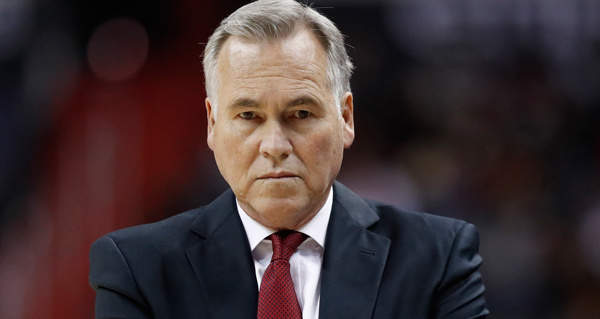We’ve made it out the other side with James Harden, just about. There was some fretting a half-decade ago, as he was coming into the full possession of his new team and the talents he didn’t get to show off quite as much in Oklahoma City, concerns about his style, the overall junkiness of it, the aloof-athletic stepbacks and the elaborate foul-baiting. But greatness wins us over, or wears us down, in the end, and Harden is a great player. He’ll win his first MVP at the end of this season. He arguably deserved two other ones in previous years. If he’s not beloved outside Houston, he is finally at least admired and appreciated.
With that established: Harden had a pretty bad series, by his standards, against the Warriors. He was amazing in their Game 1 loss, but struggled without Chris Paul in Games 6 and 7 and overall his averages were down across the board from their regular season equivalents: 28.7 PPG, 6 APG, 41.5 percent from the field and 24.4 percent from three. When he’s done playing, we’re going to think of him as in the company (or perhaps even better than) Dwyane Wade, but his career thus far still lacks an all-time Finals run like Wade had in 2006. Harden turns 29 this August. He’ll have more chances to make that happen.
In soccer, there’s a stat called expected goals that measures the aggregate quality of the shots a team attempts in a given match. It assigns every shot a less-than-one value depending on how close the player is to the goal, how sharp the angle is, how many defenders are near him, etc. So, a goal-line tap-in on an empty net is worth, say, .99 and a long-range strike is worth something like .03. This is useful insofar as it lets you know how clinical a team has been versus how often they put players in decent scoring positions. If Chelsea finishes a match with 2.31 expected goals but only scored one, they’ve either been extraordinarily unlucky or their forwards have some explaining to do.
This is something I’m making up just now, using imaginary math, but what is Mike D’Antoni’s expected championships figure up to these days? Three of his four playoff runs with the Suns ended in some strange, heartbreaking fashion or another. In 2005, the Suns likely would have lost to the Spurs in the Conference Finals regardless of whether Joe Johnson had broken his face or not, but Joe Johnson did indeed break his face, which doomed them. The next year—the Amar’e Stoudemire microfracture surgery season—was another Conference Finals loss, to the Mavericks, a six-gamer in which the Suns stole Game 1 proceeded to habitually blow early leads for the rest of the series. 2007, probably their best chance, they fell to the Spurs in the Conference Semis, losing Game 1 in part because a cut on Steve Nash’s nose wouldn’t stop bleeding during the fourth quarter. Then they very narrowly lost Game 5 after Amar’e Stoudemire and Boris Diaw were suspended for stepping onto the court and not getting anywhere near Robert Horry after Horry hip-checked Nash into the scorer’s table late in Game 4. Not being able to overcome these two close defeats, they succumbed in six.
And this year, ugggghhh: D’Antoni’s Rockets handle the Warriors for five games, put themselves in ideal position to face a Cavs team they almost definitely would have pummeled for the title, then Chris Paul pulls his hamstring, and they brick twenty-seven consecutive threes in Game 7. D’Antoni’s got like 1.6 expected championships and not a single, actual Finals appearance. If this sort of bum luck had befallen even a peevish incompetent like Randy Wittman, you would feel bad for him, but D’Antoni is both a basketball genius and a likable person. He is also, at this point, not a little bit tragic.
Here’s a list of Chris Paul’s averages in elimination series:
2008: 23.7 PPG, 10.7 APG, 55.5 TS% (West Semis vs. Spurs)
2009: 16.6 PPG, 10.4 APG, 50.5 TS% (First Round vs. Nuggets)
2011: 22 PPG, 11.5 APG, 67 TS% (First Round vs. Lakers)
2012: 12.8 PPG, 9.3 APG, 43.1 TS% (West Semis vs. Spurs)
2013: 22.8 PPG, 6.3 APG, 63.3 TS% (First Round vs. Grizz)
2014: 22.5 PPG, 11.8 APG, 61.1 TS% (West Semis vs. Thunder)
2015: 21.2 PPG, 10 APG, 61.9 TS% (West Semis vs. Rockets)
2016: 23.8 PPG, 7.3 APG, 57.5 TS% (First Round vs. Blazers)
2017: 25.3 PPG, 9.9 APG, 59.2 TS% (First Round vs. Jazz)
2018: 19.8 PPG, 4.6 APG, 52.2 TS% (West Finals vs. Warriors)
Chris Paul has gotten hurt, and his squads have been undermanned, but it’s rarely been his fault when he’s gotten bounced from the playoffs. The Rockets loss to the Warriors was, in fact, his worst elimination series since the Clippers got swept by the Spurs in 2012, and he didn’t get the opportunity to come good with his team on the doorstep of the NBA Finals for two games. Paul is divisive because he’s a complainer and a hard-ass, but he’s also the best point guard of his generation and a lot more clutch than he gets credit for.
If we’re going to do this thing where championships serve as The Ultimate Validation for players and coaches—and we are all inarguably doing it; who wins in the end matters deeply—then it’s going to be a shame if Harden, Paul, and D’Antoni don’t ever get one, even if we don’t have a taste for Harden, or we get annoyed with Paul, or we think that D’Antoni brought this on himself by ditching his iconic mustache, because they will in some way end up, in their ringlessness, imperfectly described. This isn’t something to yet worry about too much with Harden, because he’s in his late twenties, but Paul is already past his prime and D’Antoni is probably in his last head coaching gig. They don’t have much time left.
When that Finals berth slipped away from the Rockets, when Paul went lame at the end of Game 5, and again when they couldn’t hit a shot in the second half of Game 7, it was painful and calamitous and sad. In its aftermath, all you can hope for the principals is that it wasn’t also their last, best shot.



